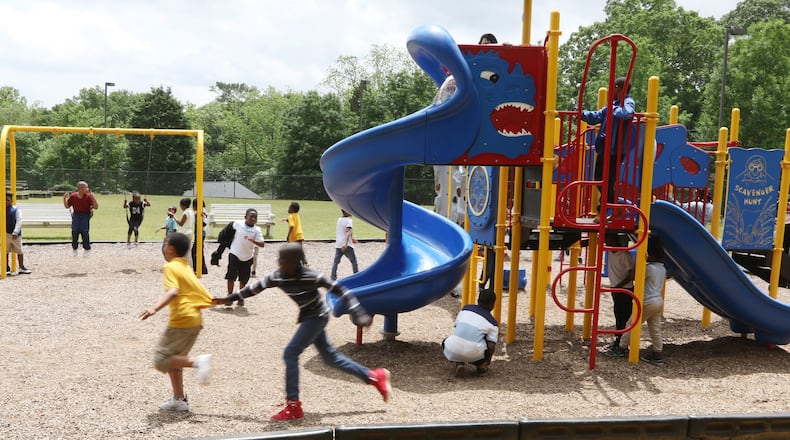At recess, the Dobbs Elementary School playground fills with children chasing each other around the large grassy field and swinging from a brightly colored swing set.
Park supporters have a plan to continue that fun long after the school day ends.
A proposed Atlanta Public Schools and City of Atlanta program would open up schoolyards for use as public parks after school, on weekends and summer breaks.
It’s part of a growing national trend to use school playgrounds to fill a void in neighborhoods that don’t have public parks within walking distance.
“We think of parks as being the hearts of communities, but the schools are similarly the center of communities,” said Michael Halicki, executive director of Park Pride.
The Atlanta park advocacy organization, along with partners including The Trust for Public Land, are helping APS and the city open three schoolyards as public parks next year. Over three years, the program would expand to include about 10 schools throughout Atlanta. If it works, more schools could be added.
The first locations will be announced this summer.
Supporters have promised to raise up to $2 million in donations to upgrade schoolyards for community use. On May 2, the Trust announced a $40,000 grant to Park Pride for planning and community engagement.
Neighborhoods and schools will provide input on how they want the parks to look. Additions could include shade trees, benches, picnic tables, signs and landscaping upgrades.
Atlanta is No. 43 in the Trust's ranking of park systems for the nation's 100 largest cities. Minneapolis topped the list, which is based on park acreage, spending, amenities and ease of access.
One third of Atlanta residents, or more than 150,000 people, live in “park deserts” — farther than a 10-minute walk of a park, according to the Trust. If every APS school doubled as a public park, nearly 80 percent of residents would be a short walk away.
Johnathan Barhite has two children who attend east Atlanta's Burgess-Peterson Academy, which backs up to I-20. The school, along with Dobbs, is one of about a dozen interested in sharing their playgrounds. The closest park on its side of the interstate is a little over a mile from the school, or about a 15-minute walk from Barhite's house.
His family can walk to the school in half that time — close enough that his children would want to go frequently so they could master the monkey bars.
“It gives the community another way to come together outside of school hours,” said Barhite, who also leads his neighborhood planning unit.
According to APS policy, playgrounds are open for community use when school is not in session, though organized groups — such as intramural sports teams or birthday parties — aren’t allowed without a permit.
In practice, the public is shut out from many schoolyards by fences and gates erected to keep students safe during the school day, officials said.
Under the pilot program, the city and school district would sign an agreement to operate the shared spaces. They still have to hammer out who’s responsible for cutting the grass, who is liable for damage and safety issues such as who will patrol the parks.
Atlanta officials pointed to examples where they already share space.
“A strong city is the result of strong neighborhoods and communities. If we can be a part of that, we definitely want to be,” said Rachel Sprecher, who leads the APS Office of Partnerships and Development.
More than 30 big cities across the United States have worked out similar joint-use agreements for parks and school spaces, said Charlie McCabe, the Boston-based director of the Trust’s Center for City Park Excellence.
About 20 years ago, New York City began converting playgrounds into after-hour public parks. Similar efforts have popped up from Los Angeles to New Orleans.
Metro Atlanta school systems have varied playground policies.
A year ago, DeKalb County School District signed a deal with the City of Brookhaven to make the playgrounds and fields at Ashford Park Elementary School available after school and on weekends. District officials want to do the same thing at other schools.
In Cobb, principals decide how the space is used when school is not in session. Clayton County’s school playgrounds aren’t open for general public use, but the district works with the county parks departments and other agencies to host events on an as-needed basis.
Fulton County Schools allows community use when it’s not an interference and also has partnered with cities and other organizations to maintain and rent fields.
John Dargle, Atlanta’s parks commissioner, said the project makes sense since the school district owns a lot of land within the city. Sharing sites is cheaper for taxpayers than buying new parkland.
His goal is to create a “seamless campus” of parks and open spaces that plug voids in the current park system.
Parks are a big priority in Annsonita Robinson’s southwest Atlanta neighborhood, where she chairs a citizen advisory council that makes planning recommendations to the city.
But the key is to connect parks with sidewalks and other safe walking routes. The program will include assessing sidewalks near schools.
“People want to be able to actually walk to a green space,” Robinson said. “They don’t necessarily want to get in their car to go to a green space.”
Atlanta schools that applied for community schoolyard project
Atlanta Classical Academy
Benteen Elementary
Booker T. Washington High School
Bunche Middle School
Burgess-Peterson Academy
Continental Colony Elementary
Dobbs Elementary
Kimberly Elementary
Morris Brandon Elementary
Parkside Elementary
Peyton Forest Elementary
About the Author
Keep Reading
The Latest
Featured



